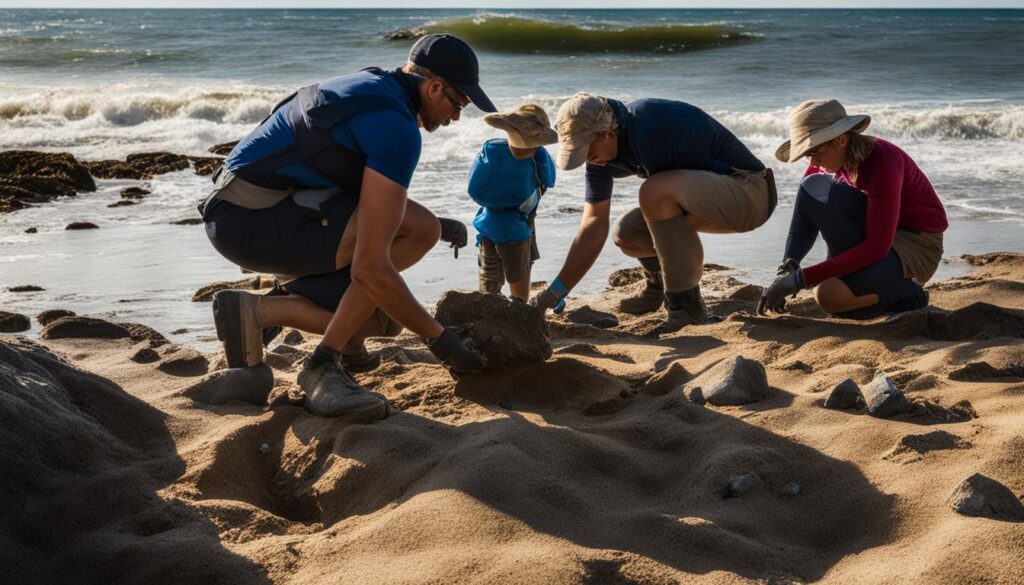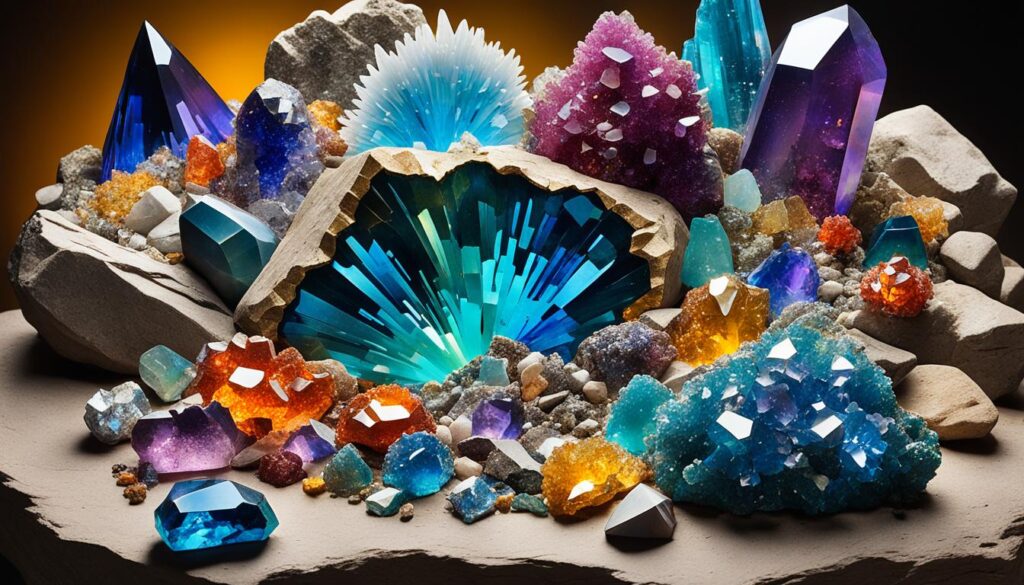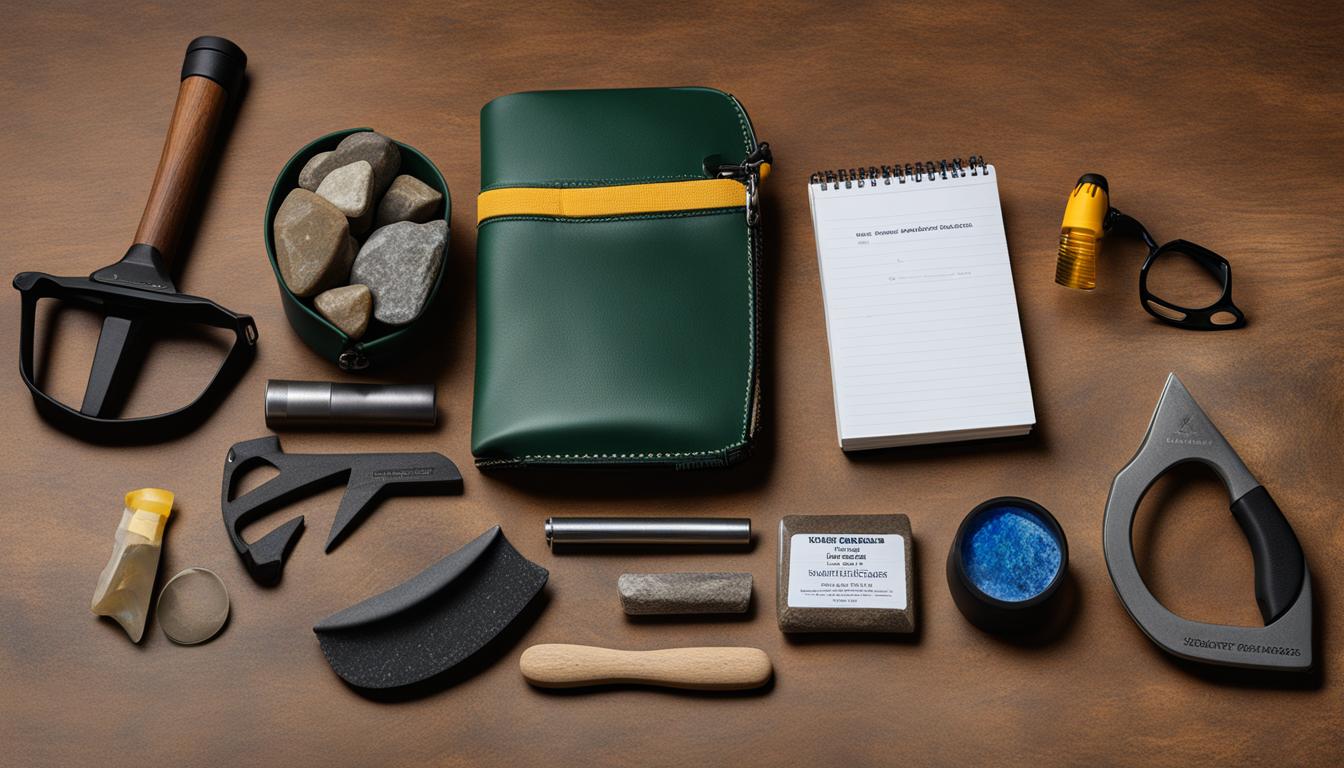This post contains affiliate links.
So, you’ve decided to take a crack at rock hounding, a pursuit that makes geology the grand adventure of your Saturday mornings. Welcome to the club—the one that trades nightclubs for mineral clubs. This rock hounding guide ensures that beginners like you would be picking out quartz from quartzite in no time and doing it with panache. Embark on an odyssey where every pebble could tell a story, and even the rocks under your feet get a second glance.
Now, let’s iron out the nitty-gritty of how to rock hound with a dash of beginner’s luck and a pinch of seasoned insight. Before you start dreaming of gemstones glistening in riverbeds or chiseling your way to victory, let’s get you versed with a collection of rockhounding tips that will have you setting out your explorer’s kit like a pro. Forewarned is forearmed, and you’re about to be armed to the teeth!
Key Takeaways
- Begin your quest by consuming all the wisdom you can gather from rock hounding guide books and local geological surveys.
- Test the waters by seeking advice from BLM, National Forest, or your nearest rock hounding club—navigate legality like a boss.
- Dive into geological reconnaissance to understand what treasures lie beneath your local terrain, and map them out.
- Don’t just stop at oohing and aahing—get your hands on the essential gear that’s the bread and butter of the craft.
- Keep your eyes peeled for fellow rockhounders—these creatures are known to roam in herds named clubs, and they’re valuable allies.
- Ready to carve out your own little piece of Earth’s history? Let’s trade elbow grease for glittering prizes. Start your engines!
Embarking on Your First Rockhounding Adventure
As you stand at the threshold of the enthralling world of rock hounding, it’s like preparing for an epic quest—geological treasures await those willing to seek them. Before the adventure truly begins, a fledgling rockhound must be equipped with knowledge as sturdy as the rocks they aim to discover. Familiarize yourself with the basics, and then dive deep into the geological wonders near you, setting the groundwork for what may become a lifetime of exploration and excitement.
Understanding the Basics of Rockhounding
The allure of rock hounding is undeniable, beckoning with the promise of uncovering Earth’s natural splendor. As a beginner rock hounder, grasp that your quest is for more than just rocks—it’s for minerals, crystals, and gemstones that bear the narrative of our planet’s history. The thrill lies in the discovery, and every find adds another piece to your growing mosaic of geological wonders. So, let’s break ground on your rock hounding guide, shall we?
Researching Your Local Geological Landscape
Embarking on this journey means becoming a detective of the land, piecing together clues to unveil the hidden hotspots where nature’s bounties lie. To excel in finding rocks and minerals, one must first understand their neighborhood’s geological makeup. This might involve studying the sediments of a local riverbed for agates or investigating whether there are historic mining areas replete with leftover mineral treasures. Consulting seasoned pros at the American Federation of Mineralogical Societies can give you the lay of the land—a proverbial ‘X’ marking the spot on your treasure map.
- Identify igneous, sedimentary, and metamorphic rocks commonly found in your vicinity.
- Scour through local libraries or online databases for maps and records of mineral deposits.
- Search for regional rock hounding clubs to gain insider knowledge on the best locales for your geology escapades.
Soak in the landscape, the veins of minerals running through it, and the eclectic formations shaped by time. With this groundwork laid and a heart filled with curiosity, you’re ready to begin your journey into the absorbing world of rock hounding!
Essential Rock Hounding Guide Tools and Equipment
Before you can shout “Eureka!” and celebrate a gemstone find, you need to gear up with the essential rockhounding equipment. An adequately stocked backpack can make the difference between a fruitful excavation and a fretful excursion. So, let’s ensure your toolkit is as prepared as you are—ready to tackle the rugged outdoors in your quest on how to rock hound like a pro.
Starting with the Right Gear
Gloves on, hammer in hand, and eyes shielded—beginning your rock hounding adventure starts with kitting out your inventory. You’ll need:
- A rock hammer: not just any hammer, but one that can split geological time.
- Chisels and shovels: for when you need to dig deep and chip away at the secrets of the Earth.
- A trusty mallet: because precision often reigns over brute force.
It’s a collection that would make any seasoned prospector nod in approval. Each item, a key to unlocking the hidden treasures just beneath our feet.
Protection and Practicality: Safety Gear and Navigational Aids
Your safety glasses and durable gloves aren’t just a fashion statement—they’re your frontline defense against rogue rock chips and deceptive dust. But beyond the protective battle against the elements, there’s an equally important need for navigational clarity:
- Never underestimate the power of a good old-fashioned map or the modern touch of a GPS device. Either way, you’re marking your journey back to civilization as well as into the wilderness.
- Sun protection is a must because the only thing more relentless than a rockhound’s spirit is the sun.
- And, of course, forward thinking includes a pair of sturdy boots—trustworthy soles for the soul-searching trekker.
Whether you’re combing through the riverbeds to pan out precious particles or scaling crags to claim crystals, proper preparation is the key to success. Consider this rock hounding guide as your toolbelt of knowledge, fortified with the right gadgets, and you’re well on your way to a glorious rockhounding rendezvous.
Finding Prime Rockhounding Locations
Every aspiring rockhound’s journey beckons with the shiny allure of discovering the perfect spot to unearth treasures beneath our feet. But before you start swinging that hammer, remember that knowledge is as pivotal as a good pickaxe when it comes to finding rocks and minerals. Now, where does one find these elusive prime rockhounding locations, you ask? The answer lies just a few keystrokes away.
The digital age has armed beginner rock hounders with the unprecedented power of information. A simple search for “rockhounding locations” can yield a treasure trove of geographic gold mines specific to your state or city. Yet, tread thoughtfully, for not all shiny spots are free to explore. Whether it’s the tempting caverns on public lands, the off-the-beaten-path private properties (with permission, of course), or the commercial dig sites where you trade greenbacks for geodes, legality is your trusty compass.
The seasoned rockhound knows that local lore is as valuable as the shiniest specimen. Digging into your state’s or region’s geological survey can unveil what official state rocks or minerals may glitter in your area. Can you imagine finding a piece of history just waiting to be picked up and pocketed? Here’s a hint: if your state has an official mineral or gem, chances are, there’s a spot famous for it!
For those hungry to turn their browsers into a tool as valuable as a geological hammer, here is the bedrock of location knowledge in a handy, no-nonsense table:
| State | Known For | Type of Location | Access |
|---|---|---|---|
| California | Gold, Quartz | Public Land/Paid Mines | Permit Required/Entry Fee |
| Arizona | Turquoise, Meteorites | Public Land/Private Property | Permit Required/Owner Permission |
| Colorado | Aquamarine, Rhodochrosite | National Parks/Paid Quarries | Restricted/Paid Entry |
| Maine | Tourmaline, Quartz | Private Mines | Paid Entry |
| Michigan | Lake Superior Agates, Copper | Beaches/Public Land | Open Access |
As you can see, each state is a chapter in a rockhound’s encyclopedia of excitement. Finding those prime rockhounding locations is much like finding rocks and minerals themselves: it takes patience, persistence, and a bit of pizazz. So, whether you’re a beginner rock hounding enthusiast or a seasoned sedimentary searcher, let the thrill of the find fuel your quest—just make sure to do it on the right side of the law, and with respect for the great outdoors.
Join a Local Rockhounding Community
Delving into the world of rockhounders without a community is like trying to find a peridot in a sea of pebbles—it’s possible, but why make it harder? Stepping into your local rockhounding clubs not only immerses you in a treasure trove of shared knowledge and experiences but also places you on the fast track to finding rocks and minerals with seasoned pros. Let’s explore the sparkling benefits of joining these vibrant communities!
Imagine having your own rock hounding guide in the form of well-weathered members always eager to help! Such wisdom is invaluable when navigates through beds of sedimentary mysteries and volcanic secrets. From stratified expanses to metamorphic mazes, veteran rockhounds can point you in the right direction while providing you with geological lore and possibly a good chuckle or two.
- Real-time tips on the best localities for new finds
- Free or low-cost access to private digging sites—like having a backstage pass to mineral heaven!
- Loaner equipment because who wouldn’t want to try before they buy?
Your journey in finding rocks and minerals doesn’t have to be a solo quest. These clubs often organize group excursions, offering the perfect blend of exploration and camaraderie. It’s in the field where bonds are formed, and samples are unearthed. Plus, there’s always that one member who brings incredible snacks—reason enough to join, we’d say!
There’s quartz in unity, and unity in quartz!
Below is an actual treasure map—a table listing some of the most active local rockhounding clubs. These are the X marks the spot where your adventures will reward you with both knowledge and specimens:
| Club Name | Location | Special Activities | Annual Dues |
|---|---|---|---|
| Glittering Gemstones Guild | New Mexico | Monthly field trips, Lapidary workshops | $20 |
| Pebble Prowlers | California | Biannual Gem Shows, Weekly digs | $35 |
| Crystal Crusaders Club | North Carolina | Private quarry access, Trade events | $25 |
| Rocks & Rendezvous | Wyoming | Educational seminars, Family-friendly outings | $15 |
With local rockhounding clubs, the adventure continues beyond the soil. Gatherings and swap meets are the social glitter where enthusiasts showcase their finds and swap stories that add layers of depth to their shimmering collection. Now, grab that rock hammer and join the league of extraordinary mineralogists!
Identifying Your Finds: The Rock Identification Guide
Gone are the days of sifting through Earth’s treasures without a clue as to what lies within your grasp; welcome to the modern rockhound’s era of enlightenment. Armed with a rock identification guide, the once-elusive secrets of earthly souvenirs unfold before your eyes, transforming each outing into a chapter of geological detective work worth a story or two.
Recognizing Rocks, Minerals, and Fossils
Surveying the day’s haul, you realize that the true adventure begins with recognizing your finds. Are they igneous, borne of fire and fury? Sedimentary, layered storytellers of time? Or perhaps metamorphic, transformed under pressure’s demanding hand? The lines, the luster, and the longevity – each facet whispers hints, guiding your next steps in finding rocks and minerals that are not mere stones, but the pages of nature’s grand narrative.
Utilizing Online Resources and Books for Identification
No longer must you meander through the maze of mineralogy alone. From the boundless database of Mindat to the curative collection within the pages of Smithsonian Handbooks, your journey in rock identification aligns with the wisdom of ages past. Seekers of geological truth—novices and experts alike—find solace in these tomes, as they turn uncertainty into certainty, doubt into discovery.
Seasoned collectors become mentors, innocent queries now insightful queries, and library resources are arsenals awaiting your inquisition. Herein lies the art of rockhounding—beyond the mere collection, it is the understanding and appreciation that elevate this pastime to a pursuit. Arm yourself with knowledge, and let these rockhounding tips be your compass on the path to becoming a true connoisseur of the crust beneath us.
Rock Hounding Guide: Rules and Etiquette of the Craft
Rock hounding isn’t just a pastime; it’s a practice woven with an array of unspoken rules and codified etiquette. To sustain our beloved profession and pursuit, there’s a need for each enthusiast to not only understand but also strictly adhere to these practices that safeguards both our planet and our hobby.
Navigating Legalities: Claims and Permissions
Gaining insight into the labyrinth of rockhounding rules begins with a sprint through the legal hoops. Obtain permissions where required, and make yourself familiar with the boundaries of your rock-hunting playground. Whether it’s private land or federal reserves, it’s wise to first ask before you haul. Respect existing claims; they’re there for a reason and your rock hounding guide manual surely doesn’t endorse property conflicts or legal kerfuffles.

Leave No Trace: Practicing Responsible Rockhounding
Donning the hat of a conscientious rock hound implies embracing the ‘Leave No Trace’ philosophy—a principle as stalwart as the geodes you’re aiming to pluck from the earth. Rockhounders are not mere visitors but guardians of geological realms. Short-term glee from unearthing treasures should never outweigh the long-term ethos of nurturing them. Lest we forget, the Earth does not belong to us; we belong to the Earth!
| Do’s | Don’ts |
|---|---|
| Acquire necessary permits. | Invade restricted areas. |
| Adhere to the daily limits of finds. | Disrupt wildlife habitats. |
| Use hand tools to reduce impact. | Leave behind waste or dig marks. |
| Rehabilitate digging sites post-exploration. | Disrespect cultural or historical sites. |
By mastering the finer nuances of how to rock hound with respect and deference, each of us can ensure that the rocks we adore today as well as the legacy we leave for future generations remains as immaculate and awe-inspiring as nature intended.
Curating Your Own Collection
Embarking on the journey of collecting rocks and minerals is not just about acquiring pieces of the earth—it’s about weaving a story of geological wonder. A novice in the realm of beginner rock hounding may initially be dazzled by the brilliance of a quartz crystal or the intricate layers of a banded agate. However, to transform a mere assemblage into a well-curated anthology that unfolds the narrative of our planet, one must adopt a methodical approach towards how to rock hound and collect.
Initially, it’s quintessential to label your earthly treasures. The magic of a collection lies in its details — the what, the where, the how of each specimen must be meticulously recorded. Fine-tune your curator’s eye, learn to discern the pedestrian pebble from the precious gem, and keep records so immaculate that they’d make a librarian blush. Here’s an illustrative guide on how to categorize your finds:
| Specimen | Location | Characteristic | Category |
|---|---|---|---|
| Quartz Crystal | Pike’s Peak, Colorado | Transparent with prism-like facets | Mineral |
| Banded Agate | Lake Superior, Michigan | Concentric rings of red and white | Mineraloid |
| Petrified Wood | Petrified Forest, Arizona | Wood structure replaced by Quartz | Fossil |
Transitioning from amateur to adept means not only honing your beginner rock hounding skills but also embracing the curator mindset. This involves the discerning choice of pieces that resonate with your personal narrative or scientific interest. Envision each specimen as a chapter of Earth’s memoir, your collection a library of lithic literature. Balance aesthetics with educational value, rarity with personal connection, and above all, celebrate each addition as a milestone in your mineralogical quest.
“In every outthrust headland, in every curving beach, in every grain of sand there is the story of the earth.” — Rachel Carson
Whether your collection sprawls across shelf after shelf, or it’s a modest display in the remotest corner of your desk, remember: Quality trumps quantity. Let each piece tell a story, let each crystal capture a memory, and allow your passion for collecting rocks and minerals to be the beacon that guides you through the rugged terrains and riverbeds on this exhilarating quest.
Best Rocks for Collecting: Starting Your Personal Gallery
Every beginner rock hound has a moment when a sparkly mineral catches their eye, heralding the start of a lifelong passion. Venturing into the world of best rocks for collecting can be both exhilarating and overwhelming. But fear not! By focusing on distinctive features and inherent beauty, newcomers can create their own riveting gallery of geological wonders. Allow your curiosity to guide your collection, and let’s delve into the sophistication of starting your personal assembly of earthly treasures.

Selecting Specimens: What to Look for as a Beginner
Embarking on the journey of beginner rock hounding means playing a delightful version of nature’s bingo. You’re not just looking for the flashiest or the biggest rocks—you are, in essence, curating a collection that tells a story of geological history and personal growth. Here’s a handy table to help you discern which specimens might be most suitable to start your collection:
| Type | Characteristics | Significance | Availability |
|---|---|---|---|
| Quartz | Glistening, various colors | Abundant, versatile for display | Common |
| Agates | Banded patterns, colorful | Excellent for beginners, decorative | Region-specific |
| Fossils | Historical significance, textured | Window into the past | Varies with local geology |
| Geodes | Unassuming outside, crystalline inside | Surprise element, mesmerizing interiors | Fairly Common |
As your collection evolves, so will your ability to spot the indispensable from the ordinary—each rock becoming a stepping stone in your hounding repertoire.
Maintenance and Display: Preserving Your Collection
Upholding the integrity of your collection is not just about stacking the shinies on a shelf. Maintaining rock collection requires a touch of finesse and a dash of practicality. It’s about creating a space where each individual piece shines while ensuring they’re preserved for the saga of time. A clean, labeled, and thoughtfully placed array is a sight of beauty, but it serves a loftier purpose – to protect and showcase your geological journey with pride. Let your collection gleam with the brilliance of care and showcase your dedication to this enduring craft.
Conclusion
Embarking on the rockhounding quest is the beginning of an endless path of discovery and friendship. This ultimate rock hounding guide aimed to lay the foundation for beginners, equipping them with the basics, yet rock hounding is far more than knowing which hammer to swing or what crystal twinkles in the sun—it’s a perpetual cycle of learning and exploration.
Encouraging Continuous Learning and Exploration
Every rock, every mineral, has a story that spans eons, and each discovery is another chapter in an ever-unfolding narrative. The rockhounding community thrives on this constant progression of knowledge, with each expedition potentially unveiling geological secrets yet to be understood. As you delve deeper into this hobby, allow curiosity to be your compass, guiding you to vast landscapes and unearthing the mysteries buried beneath.
Building a Community: Sharing Your Passion with Others
A single rock can spark a connection, a shared fascination turning strangers into comrades. Sharing your passion within the rockhounding community isn’t just about showing off your latest find—it’s about weaving your own experiences into the larger tapestry of collective wisdom. By coming together, rockhounders create a dynamic, vibrant culture that not only preserves the integrity of this cherished pastime but also propels it forward for future aficionados to enjoy. So go on, share your tales of the trail, and let the bonds forged with fellow enthusiasts enrich the rockhounding canvas with every brushstroke.
FAQ
What is rock hounding and how do I get started?
Rock hounding is the recreational collection of rocks, minerals, crystals, and gemstones from their natural environment. To get started, familiarize yourself with the basic concepts, gather some essential tools, and begin researching your local geological landscape for potential rockhounding spots.
What kind of equipment do I need for beginner rockhounding?
As a beginner, you’ll want to start with some fundamental gear such as a rock hammer, shovel, chisel, safety glasses, gloves, sturdy footwear, and navigational aids like maps or a GPS device. These will help you safely and effectively find and retrieve rocks and minerals.
Where can I go to find rocks and minerals?
Start your search online, looking up rockhounding locations by state or city. You can collect on public lands with appropriate rules or on private property with permission. Be mindful of legal guidelines and ensure you’re not trespassing or breaking any laws in your pursuit.
Is joining a local rockhounding club beneficial?
Absolutely! Being part of a local rockhounding club can provide valuable insights, organized trips, and the opportunity to learn from experienced collectors. Clubs often share resources and can offer access to special locations for members.
How do I identify the rocks and minerals I find?
Identification can be done using online resources like Mindat, as well as reference books such as those from the Smithsonian Handbooks series. Many enthusiasts also suggest consulting with more experienced rockhounders and attending local club meetings for assistance.
What are some rockhounding rules and etiquette I should be aware of?
Rockhounding rules include obtaining appropriate permissions, respecting property rights, and not collecting in prohibited areas. Ethically, it’s important to practice ‘Leave No Trace’ principles to preserve natural sites for future generations.
How should I go about curating my own rock and mineral collection?
Start by cataloging your finds with detailed labels and information. Focus on quality over quantity, selecting unique specimens. Consider proper storage, like display cabinets, and invest time in learning how to trim, clean, and display your collection to preserve their conditions.
What are the best rocks for collecting as a beginner?
Look for rocks and minerals that are unique to your area or those that catch your interest due to their characteristics or aesthetics. Beginner-friendly specimens often include quartz, agates, or local state minerals which are easier to identify and collect.
How can I actively participate in the rockhounding community?
Engage with the community by attending club meetings, joining online forums, and participating in field trips. Share your experiences, exchange specimens, and contribute to collective knowledge to enrich both your experience and that of others in the community.
Source Links
- https://howtofindrocks.com/how-to-start-rockhounding/
- https://www.unearthedstore.com/blogs/guides/beginners-guide-to-rockhounding
- https://www.irocks.com/rock-and-mineral-collecting-for-beginners
This post contains affiliate links.

